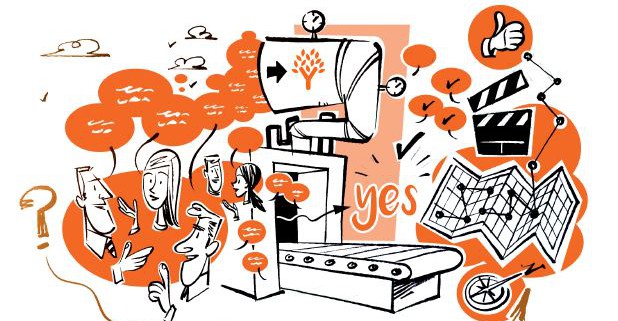Recently, we facilitated an online summit with managers and directors of Rastreator in which we worked on transversal collaboration in order to think big.
We dreamt about a common future and worked in groups on the initiatives necessary to get us there.
We are remembering this project, so as to speak about, once again, the importance of creating in organizations an image of the future sufficiently attractive to mobilize everyone towards the required action.
This image of the future is generated in the first two phases of Appreciative Inquiry, which is one of the methodologies we use in Madavi. These two phases are: Discovery and Dream.
Discovery refers to all of us agreeing about “what is the best of what is”, that is to say, the strengths and resources of the organization as a whole, a viewpoint from abundance; inquire into “what we DO have” instead of analyzing “what we DO NOT have”.
If you inquire into what you DO have you will be successful
The next step is to maintain a dialogue with a lot of people on what our organization would be like if we used all our potential. An image of the future created in this fashion complies with all that is necessary to be highly mobilizing: it will be ambitious and possible because it is based on “what we DO have and gives us success”, which, by definition, is a lot.
When the image of the future is attractive, it generates an energy that launches us towards that “dream”
When the image of the future is attractive, is when we believe it to be much better than the present moment for the group and for oneself, and it generates an energy that launches us towards that “dream” creating strategies, products, services, attracting resources, talent and initiatives.
If we have an attractive, ambitious, and possible image of the future, sufficient energy will arise to change our behavior and mobilize us into action.
In this manner – by aligning strengths towards aspirations – areas of opportunity and initiatives arise which the very next day are put into effect and as we say in Madavi “without asking for pardon or permission”. Everybody mobilizing towards a common objective, to reach that attractive image of the future.
Change based on strengths is our flag. Does anyone base their success on their weaknesses?
Methodologies to have success in a process of change.
Appreciative Inquiry is our principal methodology. Other methodologies we use are: Positive Deviation, a form of change based on observing those people who achieve exceptional results with the same resources, a methodology Madavi uses to generate action within the team; Conversations Worth Having, those from which you emerge with more energy than with which you entered and with more ideas about how to succeed; SOAR, working your Strengths, Opportunities, Aspirations and Results, instead of the classical SWOT; Focus on solution and Thinking Partner, a methodology which facilitates processes of reflection and co-creation in work teams.


